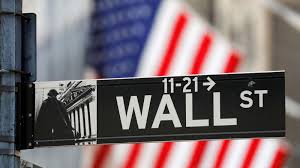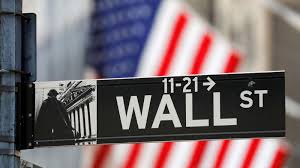
Wall Street's primary indexes had mixed results on Thursday as traders evaluated GDP data that was better than anticipated and exercised caution following a tech-related sell-off the previous day.
Data revealed that the second quarter U.S. economic growth was 2.8%, above predictions of 2%; nonetheless, inflation declined, maintaining expectations of a rate decrease in September.
According to Peter Cardillo, chief market analyst at Spartan Capital Securities, "the growth rate was higher than what we were looking for, but the good news is that the economy expanded as consumers spent more as inflation dropped in the second quarter."
"This is a good sign in terms of the economy."
Megacap stocks were mixed following the previous session's crushing of the so-called "Magnificent Seven" group of tech firms by Alphabet and Tesla's poor results. The selloff caused the Nasdaq and S&P 500 to have their worst day since 2022.
On Thursday, Tesla increased 2.6% following a 12% decline the day before, while Nvidia, Alphabet, and Microsoft fell between 0.4% and 0.9%.
Following Teradyne's 13% decline, which opened a new tab after the manufacturer of chip-testing equipment anticipated lower-than-expected third-quarter sales, semiconductor stocks also generally declined. 1.6% was lost by the semiconductor index.
Although the heavyweight stock group has driven the stock market to record highs this year, Wednesday's selloff strengthened concerns that these firms may be overvalued and in danger of more troubled times.
"There is so much pull ahead in terms of share prices, earnings forecasts with AI that we are seeing some fatigue setting in," said Jake Dollarhide, chief executive officer at Longbow Asset Management.
Following a 2% decline in the previous session, the small-cap Russell 2000 outperformed, climbing 0.7% as investors began to find more value in moving to trailing sectors.
The "fear gauge" on Wall Street somewhat decreased but remained close to its peak since April 19.
After a recent trend of reducing inflation and some weakness in the labour market, investors are waiting for the personal consumption expenditures (PCE) price data, which is coming on Friday, to confirm speculations of an early start to the Federal Reserve's rate reduction.
According to CME's FedWatch Tool, the odds of a 25-basis-point decrease in September increased slightly to over 88% from roughly 78% before Thursday's data.
Based on LSEG statistics, market players are also factoring in a minimum of two rate reductions by December of this year.
When the trading opened at 9:46 a.m. ET, the Dow Jones Industrial Average had gained 111.84 points, or 0.28%, to 39,965.71, the S&P 500 had decreased 4.15 points, or 0.08%, to 5,422.98, and the Nasdaq Composite had decreased 76.93 points, or 0.44%, to 17,265.48.
Among moves driven by earnings, American Airlines gained 4.5%, reversing premarket losses after lowering its annual profit forecast, while Ford fell 17.2% as the automaker's second-quarter adjusted profit greatly missed estimates.
Edwards Lifesciences tumbled 23.8%, the biggest decliner on the S&P 500, after missing second-quarter revenue estimates.
Advancing issues outnumbered decliners by a 1.84-to-1 ratio on the NYSE and by a 1.52-to-1 ratio on the Nasdaq.
While the Nasdaq registered 45 new highs and 37 new lows, the S&P index recorded 25 new 52-week highs and 8 new lows.
(Source:www.tradingview.com)
Data revealed that the second quarter U.S. economic growth was 2.8%, above predictions of 2%; nonetheless, inflation declined, maintaining expectations of a rate decrease in September.
According to Peter Cardillo, chief market analyst at Spartan Capital Securities, "the growth rate was higher than what we were looking for, but the good news is that the economy expanded as consumers spent more as inflation dropped in the second quarter."
"This is a good sign in terms of the economy."
Megacap stocks were mixed following the previous session's crushing of the so-called "Magnificent Seven" group of tech firms by Alphabet and Tesla's poor results. The selloff caused the Nasdaq and S&P 500 to have their worst day since 2022.
On Thursday, Tesla increased 2.6% following a 12% decline the day before, while Nvidia, Alphabet, and Microsoft fell between 0.4% and 0.9%.
Following Teradyne's 13% decline, which opened a new tab after the manufacturer of chip-testing equipment anticipated lower-than-expected third-quarter sales, semiconductor stocks also generally declined. 1.6% was lost by the semiconductor index.
Although the heavyweight stock group has driven the stock market to record highs this year, Wednesday's selloff strengthened concerns that these firms may be overvalued and in danger of more troubled times.
"There is so much pull ahead in terms of share prices, earnings forecasts with AI that we are seeing some fatigue setting in," said Jake Dollarhide, chief executive officer at Longbow Asset Management.
Following a 2% decline in the previous session, the small-cap Russell 2000 outperformed, climbing 0.7% as investors began to find more value in moving to trailing sectors.
The "fear gauge" on Wall Street somewhat decreased but remained close to its peak since April 19.
After a recent trend of reducing inflation and some weakness in the labour market, investors are waiting for the personal consumption expenditures (PCE) price data, which is coming on Friday, to confirm speculations of an early start to the Federal Reserve's rate reduction.
According to CME's FedWatch Tool, the odds of a 25-basis-point decrease in September increased slightly to over 88% from roughly 78% before Thursday's data.
Based on LSEG statistics, market players are also factoring in a minimum of two rate reductions by December of this year.
When the trading opened at 9:46 a.m. ET, the Dow Jones Industrial Average had gained 111.84 points, or 0.28%, to 39,965.71, the S&P 500 had decreased 4.15 points, or 0.08%, to 5,422.98, and the Nasdaq Composite had decreased 76.93 points, or 0.44%, to 17,265.48.
Among moves driven by earnings, American Airlines gained 4.5%, reversing premarket losses after lowering its annual profit forecast, while Ford fell 17.2% as the automaker's second-quarter adjusted profit greatly missed estimates.
Edwards Lifesciences tumbled 23.8%, the biggest decliner on the S&P 500, after missing second-quarter revenue estimates.
Advancing issues outnumbered decliners by a 1.84-to-1 ratio on the NYSE and by a 1.52-to-1 ratio on the Nasdaq.
While the Nasdaq registered 45 new highs and 37 new lows, the S&P index recorded 25 new 52-week highs and 8 new lows.
(Source:www.tradingview.com)





